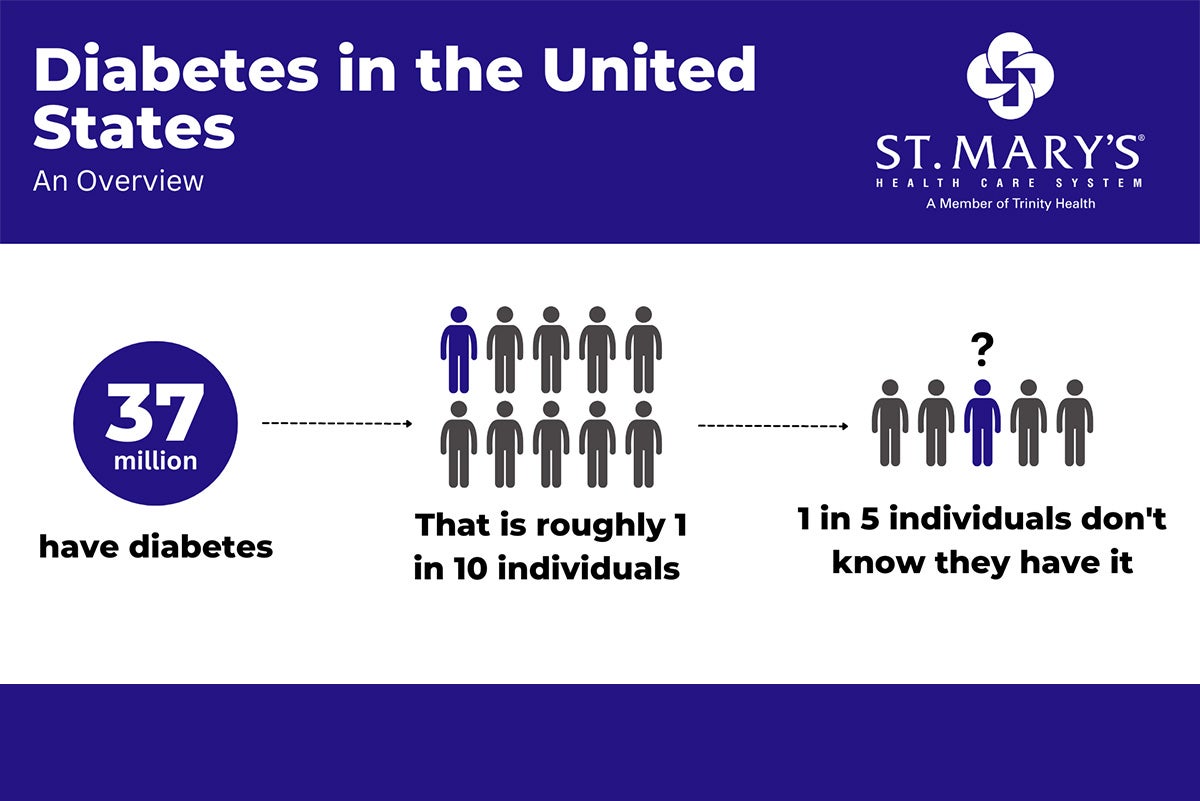3 Steps to Reduce Your Risk of Diabetes
March 19, 2023Over 37 million adults in the United States currently have diabetes, and 20% of them don’t know they have it. Diabetes is a chronic condition that affects how your body turns food into energy. When we eat food, our body converts it into sugar (glucose) and releases it into our bloodstream. Our pancreas then releases insulin to convert this sugar into energy.
Some people’s pancreas may not make enough insulin, or their body may not respond as well as it should to sugar. High levels of sugar in your blood can cause other chronic health problems like heart disease, vision loss, kidney disease, and even limb loss. There are three types of diabetes: Type 1, Type 2, and Gestational (during pregnancy). Type 2 Diabetes, the most common type, will be the main focus of this blog.
Are you at risk for Type 2 Diabetes?
You may be at risk for type 2 diabetes if you have a family history of diabetes, are overweight, have prediabetes, are 45 years or older, and/or are physically inactive. Prediabetes occurs when a person’s blood glucose is higher than normal, but not high enough to be considered type 2 diabetes. Ethnic groups such as African American, Hispanic or Latino, American Indians, Alaska Natives, Pacific Islanders, and Asian Americans are at a higher risk of type 2 diabetes, as well.
Many of these minority groups experience increased rates of disease and poor health due to a combination of multiple factors. These factors include, but are not limited to, poverty, environmental threats, lack of access to resources, educational inequalities, and behavioral factors.
While there isn’t currently a cure for diabetes, there are several steps you can take to prevent type 2 diabetes. More than 33% of American adults have prediabetes, which means they are at an increased risk for type 2 diabetes. The good news about a prediabetes diagnosis is that it can be reversed through healthy lifestyle changes.
3 Steps to Reduce Your Risk
1. Choose the best foods and make a plan
- Eat more fruit and veggies.
- Add lean proteins like fish, chicken, and turkey to your diet.
- Reduce fried foods, packaged/processed foods, alcohol, and sweetened beverages.
Healthy eating is an important factor in preventing type 2 diabetes. Choosing to eat well has a large array of benefits. While it will help you lose weight, it can also balance your body and mind. The Centers for Disease Control and Prevention (CDC) recommends creating a healthy eating plan that works for you. A good eating plan includes more non-starchy vegetables like zucchini, broccoli, and spinach, and less added sugars that often come with pre-packaged snacks. Learn great hints from CDC about meal planning, grocery shopping, reading food labels, and eating out.
2. Keep moving and set an activity goal
- The CDC recommends at least 150 minutes per week of moderately intense activity.
- Exercise increases your brain’s production of endorphins (feel-good hormones), so while you are preventing diabetes, you are also making yourself happier.
Physical activity is another important contributing factors to the prevention of type 2 diabetes. The CDC recommends all adults have at least 150 minutes of moderate-intensity physical activity daily. Adding some form of exercise to your day for thirty minutes can help control your blood sugar, blood pressure, cholesterol, and weight. Exercise can also help you feel happier, sleep better, and improve your memory.
Examples of everyday activities that are considered moderate intensity are dancing, bicycling, walking swiftly, and mowing the lawn. If you have doubts about staying motivated, find a partner and something you enjoy. An activity buddy can make adding physical activity to your daily life easier.
3. Join a healthy lifestyle educational program
- St. Mary’s Healthcare System’s PreventT2 Program is aimed at preventing diabetes.
- Increasing physical activity and losing a small amount of weight is proven to prevent or delay onset of type 2 diabetes.
The Prevent T2 Program is a National Diabetes Prevention lifestyle change program developed by the CDC that has been proven to help prevent or delay type 2 diabetes. Throughout the program, participants learn to change behaviors around eating and physical activity. Participants also learn skills needed to sustain those healthy lifestyle changes once the program is complete. To participate, you must be aged 18 or older, overweight, not diagnosed with type 1 or type 2 diabetes, and not currently pregnant. You also need to meet one of the following criteria:
- Diagnosed with prediabetes
- Previously diagnosed with gestational diabetes
- Received a high-risk result on the prediabetes risk test. Take the CDC’s Prediabetes Risk Test.
What else can you do?
Reduce Stress
Physical and mental stress can negatively affect blood glucose levels, increasing risk for type 2 diabetes. Ways to reduce stress include practicing relaxation skills, maintaining a positive attitude, and exercising!
Talk to trusted friends
Talk about struggles you are having and ask friends if they have advice. Join a prediabetes support community. These are safe spaces for people with similar struggles to talk openly without feeling judgment and remain motivated to achieve their goals. Share your accomplishments with encouraging people in your life.
Preventing type 2 diabetes can be difficult, but the CDC has worked to make it much easier. If you aren’t quite ready to join a lifestyle change program or are waiting for your class to start, get started with a practical guide called On Your Way to Preventing Type 2 Diabetes. The guide helps to take small steps that add up to a healthier lifestyle (CDC, 2022).




